Aetiology
Paediatric plant poisoning usually involves exposure to very small amounts of the plant and is usually caused by accidental ingestion and environmental experimentation. Children are particularly vulnerable to toxicity from medicinal plant products.[31]
Adult plant poisoning typically involves exposure to larger amounts of the plant as the result of misidentification of different plant species or concentrating the plant products into an extract or tea.
Consumption of contaminated, unfiltered water can lead to ingestion of peptide microcystins from blue-green algae.[6]
Pathophysiology
Abdominal cramping, vomiting, and/or diarrhoea may occur from ingestion of certain plants due to direct irritant effects on the gastrointestinal mucosa or indirect effects causing increased vagal tone. Vomiting and cramping can occur after ingestion of virtually any plant. Many plants can also cause diarrhoea from direct stimulation of muscarinic receptors by cholinergic alkaloids, or indirectly via bulk and osmotic bowel stimulation. Toxins include:
Phytolacca toxin and mitogen (from pokeweed and inkberry)
Saponin glycosides (from holly berries)[Figure caption and citation for the preceding image starts]: HollyFrom private collection of Gerald O'Malley [Citation ends].

Viscumin (from mistletoe)
Emetine and cephaline alkaloids (from ipecac syrup)
Solanine from solanaceous plants
Ribosome-inactivating protein 2 (castor bean [contains ricin; Ricinus communis], rosary pea [contains abrin; Abrus precatorius], black locust [Robinia pseudoacacia]).
Liver necrosis may occur due to the following:
Atractyloside (e.g., from distaff thistle): a glycoside that inhibits oxidative phosphorylation in the liver.
Peptide microcystins (e.g., from blue-green algae): cyanotoxins that cause liver necrosis by dissociation of the hepatocytes, hydropic degeneration, and intrahepatic pooling of blood.
Pyrrolizidine alkaloid (e.g., from ragworts, other Senecio species, rattleweeds, and Heliotropium species): metabolised to pyrroles that bind both proteins and nucleic acids within hepatocytes. The pyrroles have an antimitotic effect on hepatocytes, forming megalocytes, which die and are replaced with fibrous tissue instead of normal hepatocytes. Ultimately, the liver fails due to hepatocellular death and fibrosis.[Figure caption and citation for the preceding image starts]: SenecioFrom private collection of Gerald O'Malley [Citation ends].
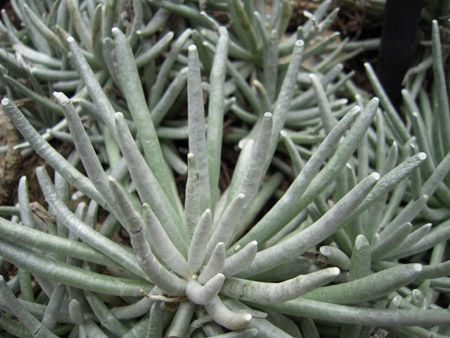
Kavalactone, kavain, and flavokavain B (e.g., from kava kava): the exact mechanism of liver injury is unclear. Cytotoxicity can be demonstrated in animal models.
Nordihydroguaiaretic acid (e.g., from creosote bush): a polyphenol that causes peroxidation of hepatocyte membrane lipids and DNA double-strand breaks. Administration is associated with a time- and dose-dependent increase in serum alanine aminotransferase levels and lactate dehydrogenase, suggesting liver damage.
Bradyarrhythmias and heart block may occur due to the following:
Cardiac glycosides (e.g., from lily of the valley, foxglove, oleander, and red squill species): cardioactive steroids with actions on the heart that are virtually identical to those of digoxin. Digoxin-like cardioactive steroids cause bradycardia by increasing intracellular calcium, which results in slowed transmission through the atrioventricular node.[Figure caption and citation for the preceding image starts]: OleanderFrom private collection of Gerald O'Malley [Citation ends].
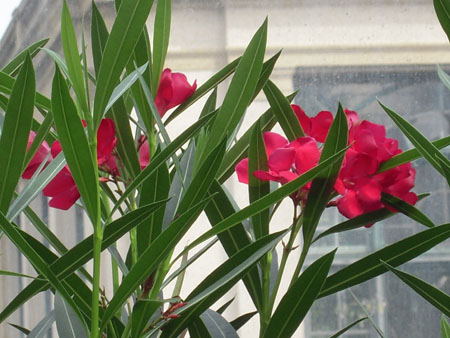
Ventricular arrhythmias may occur due to the following:
Taxine alkaloids (e.g., from yew leaves and seeds): causes sodium channel blockade.[Figure caption and citation for the preceding image starts]: YewFrom private collection of Gerald O'Malley [Citation ends].
 [Figure caption and citation for the preceding image starts]: YewFrom private collection of Gerald O'Malley [Citation ends].
[Figure caption and citation for the preceding image starts]: YewFrom private collection of Gerald O'Malley [Citation ends].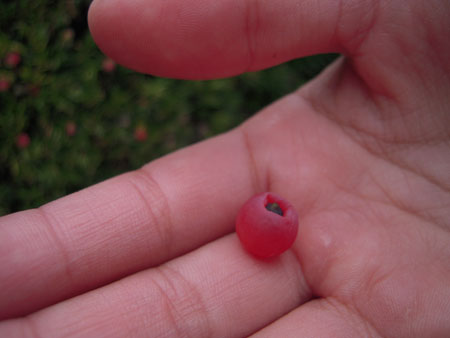
Aconitine alkaloids (from monkshood): causes sodium channel opening and calcium channel blockade.
Saponins from pokeweed: causes heart block due to vagal stimulation.
Tachyarrhythmias and hypertension may occur due to the following:[8]
Nicotine-like alkaloids (e.g., from blue cohosh, poison hemlock, golden chain, Indian tobacco, lupin, laburnum, and tobacco): bind to nicotinic acetylcholine receptors, increase levels of several neurotransmitters, and increase release of adrenaline from splanchnic nerves in the adrenal medulla.[32]
Caffeine, theophylline, synephrine, norephedrine (phenylpropanolamine), and ephedrine-like stimulants (e.g., from green tea, yerba mate, bitter orange, bala, ma huang): ephedrine is a sympathomimetic amine that increases postsynaptic noradrenergic receptor activity, resulting in increased heart rate and BP. Because ephedrine does not cross the blood-brain-barrier well, the effects are most pronounced in the peripheral nervous system.
Cathinone (e.g., from khat) and synthetic cathinone derivatives (mephedrone): a monoamine alkaloid chemically similar to amfetamines. It induces the release of dopamine, which causes increased heart rate and BP.
Peripheral neuropathies and neuromuscular weakness may occur due to the following:[16][17]
Aconitine alkaloids (e.g., from monkshood): cause opening of sodium channels in neurones, resulting in decreased transmission of the action potential.
Strychnine alkaloids (e.g., from poison nut, quaker button, strychnos seed): act as antagonists at the inhibitory glycine receptor (a ligand-gated chloride channel in the spinal cord and the brain). This results in loss of control of large muscle groups with an intact mental status.
Curare alkaloids (e.g., from Chondrodendron tomentosum, and Strychnos toxifera): competitive antagonists at the nicotinic acetylcholine receptor (nAChR), one of the two types of acetylcholine (ACh) receptors. D-tubocurare occupies the same position as ACh, resulting in muscle fasciculation, weakness, and seizures.
Brucine alkaloids (e.g., from poison nut, quaker button, strychnos seed): structurally and chemically similar to strychnine alkaloids, with similar toxicities (antagonism of glycine receptors in the brain and spinal cord).
Grayanotoxins (e.g., from azalea, fetterbush, Kalmia species): bind to specific sodium ion channels in cell membranes (receptor sites involved in activation and inactivation). They prevent inactivation of the cell membranes, leaving excitable cells depolarised and paralysed.
Karwinskia toxins (e.g., from buckthorn, coyotilla, tullidora): cause the destruction of Schwann cells.
Seizures may occur due to the following:[18][33]
Cicutoxin (e.g., from water hemlock, other Cicuta species): believed to be a gamma-aminobutyric acid (GABA) antagonist that prevents inhibitory inward chloride currents in the central nervous system (CNS), resulting in CNS stimulation and seizures.[Figure caption and citation for the preceding image starts]: CicutaFrom private collection of Gerald O'Malley [Citation ends].
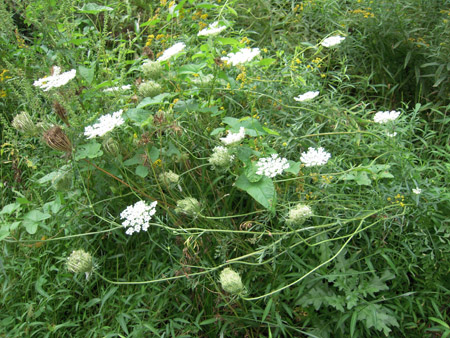 [Figure caption and citation for the preceding image starts]: CicutaFrom private collection of Gerald O'Malley [Citation ends].
[Figure caption and citation for the preceding image starts]: CicutaFrom private collection of Gerald O'Malley [Citation ends].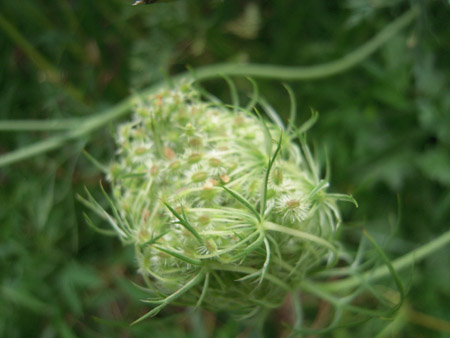 [Figure caption and citation for the preceding image starts]: CicutaFrom private collection of Gerald O'Malley [Citation ends].
[Figure caption and citation for the preceding image starts]: CicutaFrom private collection of Gerald O'Malley [Citation ends].
Nicotine (e.g., blue cohosh, poison hemlock, golden chain, Indian tobacco, lupin, laburnum, or tobacco): causes CNS stimulation via stimulation of the nicotinic parasympathetic nervous system.
Thujone (e.g., from wormwood, tansy, sage, absinthe): a GABA-A receptor antagonist. Inhibition of GABA receptor disrupts the balance between excitatory and inhibitory neurotransmission, leading to uninterrupted stimulation causing muscle spasms and convulsions.[Figure caption and citation for the preceding image starts]: WormwoodFrom private collection of Gerald O'Malley [Citation ends].
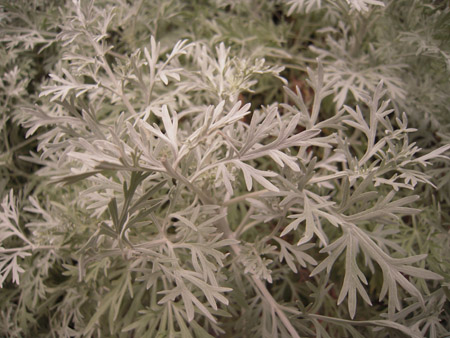 [Figure caption and citation for the preceding image starts]: Blue sageFrom private collection of Gerald O'Malley [Citation ends].
[Figure caption and citation for the preceding image starts]: Blue sageFrom private collection of Gerald O'Malley [Citation ends]. [Figure caption and citation for the preceding image starts]: Blue sageFrom private collection of Gerald O'Malley [Citation ends].
[Figure caption and citation for the preceding image starts]: Blue sageFrom private collection of Gerald O'Malley [Citation ends].
Anisatin (e.g., from Japanese star anise): suspected of being a strong GABA antagonist, preventing inhibitory inward chloride currents in the CNS, resulting in CNS stimulation and seizures.[Figure caption and citation for the preceding image starts]: Star aniseFrom private collection of Gerald O'Malley [Citation ends].
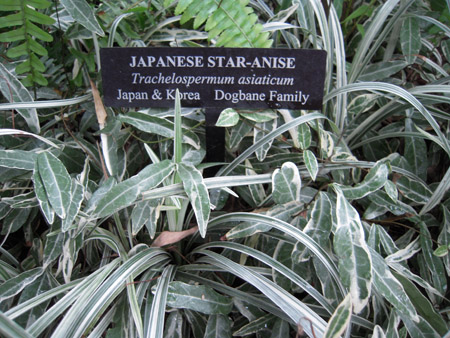 [Figure caption and citation for the preceding image starts]: Star aniseFrom private collection of Gerald O'Malley [Citation ends].
[Figure caption and citation for the preceding image starts]: Star aniseFrom private collection of Gerald O'Malley [Citation ends].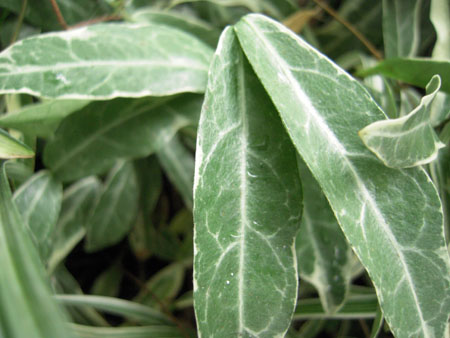 [Figure caption and citation for the preceding image starts]: Star aniseFrom private collection of Gerald O'Malley [Citation ends].
[Figure caption and citation for the preceding image starts]: Star aniseFrom private collection of Gerald O'Malley [Citation ends].
Strychnine alkaloids (e.g., from poison nut, quaker button, strychnos seed): act as antagonists at the inhibitory glycine receptor (ligand-gated chloride channel in the spinal cord and the brain), which results in loss of control of large muscle groups with an intact mental status.
Hypoglycins A and B (e.g., from ackee fruit, lychee [litchi] fruit): cause hypoglycaemia.
Cyanogenic glycoside amygdalin (e.g., from cassava): can cause acidosis via mitochondrial interference and uncoupling of oxidative phosphorylation when seeds are chewed.
Cyanogenic glycoside linamarin (e.g., from Prunus species): can cause acidosis via mitochondrial interference and uncoupling of oxidative phosphorylation when seeds are chewed.
Gelsemine blocks nicotinic receptors and can cause seizures.[14]
Hallucinations may occur due to the following:[12]
Lysergic acid/LSA (e.g., from Hawaiian baby woodrose and morning glory): has psychedelic effects thought to be due to a strong partial agonist effect at 5-HT2A receptors, which is believed to result in increased glutamate release and excitation in the cerebral cortex.
Mescaline alkaloid (e.g., from peyote cactus): psychedelic effects of mescaline are thought to be similar to LSA and are due to a strong partial agonist effect at 5-HT2A receptors, resulting in increased glutamate release and excitation in the cerebral cortex.
Thujone (e.g., from wormwood oil, sage oil, cedar oil): a GABA-A receptor antagonist. Inhibition of GABA receptors disrupts the balance between excitatory and inhibitory neurotransmission, leading to uninterrupted stimulation causing muscle spasms and convulsions.
Opiates (e.g., from opium poppy seeds): cause activation of opiate mu receptors.
Tetrahydrocannabinol (e.g., from marijuana) and synthetic CB1 agonists (JWH 018): an agonist at the cannabinoid receptor CB1 (most abundant G protein-coupled receptor in the brain).
Cocaine alkaloid (e.g., from coca): a dopamine reuptake inhibitor, a noradrenaline reuptake inhibitor, and a serotonin reuptake inhibitor, which collectively causes CNS hyperexcitability.
Nutmeg: in very large doses can cause delirium, a sense of blood rushing to the head, euphoria, and dissociation.
Salvinorin A is a selective kappa opiate receptor agonist with no effect at 5-HT2A receptors.
Delirium and hallucinations may occur from the central antimuscarinic effects of plants containing belladonna alkaloids (jimson weed, Datura, Brugmansia species).
[Figure caption and citation for the preceding image starts]: Datura white flowerBy L_A_V via Pixabay [Citation ends].
 [Figure caption and citation for the preceding image starts]: Datura seedBy PublicDomainPictures via Pixabay [Citation ends].
[Figure caption and citation for the preceding image starts]: Datura seedBy PublicDomainPictures via Pixabay [Citation ends].
Cathinone (from khat) and synthetic cathinones (mephedrone) have amfetamine-like CNS stimulation.
Coagulopathy may occur due to the following:[23]
Coumarin-containing phenylpropanoids/ginkgolides (e.g., from sweet vernal grass, tonka beans, bedstraw, sweet clover, red clover, and horse chestnut): inhibit platelet aggregation.
Bone marrow suppression may occur due to the following:[24]
Colchicine alkaloids (e.g., from autumn crocus, meadow saffron): have antimitotic effects.
Vincristine and vinblastine alkaloids (e.g., from Madagascar periwinkle): have antimitotic effects.
Podophyllum alkaloids (e.g., from North American mayapple, Podophyllum species): have antimitotic effects.
Ricin-like (type 2) ribosome-inactivating proteins (e.g., from castor bean [Ricinus communis]): have cytotoxic effects.[Figure caption and citation for the preceding image starts]: Castor beanFrom private collection of Gerald O'Malley [Citation ends].
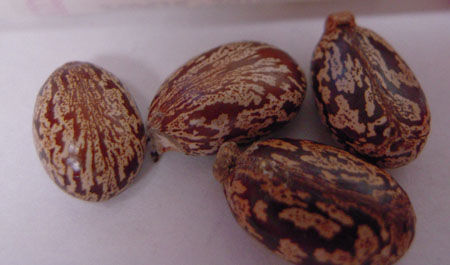
Hypoglycins A and B (e.g., from ackee fruit): have cytotoxic effects.
Dermatitis and mucous membrane irritation may occur due to the following:[21]
Phenylpropanoid (from chili or cayenne peppers): causes release of substance P from local sensory nerve endings, leading to intense burning pain.[34][Figure caption and citation for the preceding image starts]: CapsicumFrom private collection of Gerald O'Malley [Citation ends].
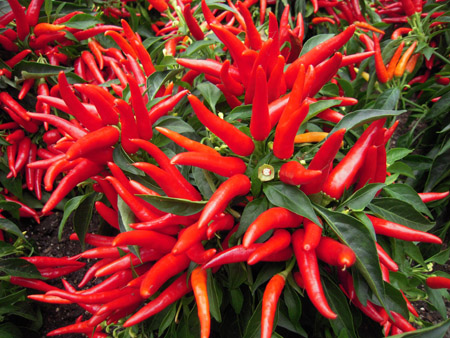 [Figure caption and citation for the preceding image starts]: CapsicumFrom private collection of Gerald O'Malley [Citation ends].
[Figure caption and citation for the preceding image starts]: CapsicumFrom private collection of Gerald O'Malley [Citation ends]. [Figure caption and citation for the preceding image starts]: CapsicumFrom private collection of Gerald O'Malley [Citation ends].
[Figure caption and citation for the preceding image starts]: CapsicumFrom private collection of Gerald O'Malley [Citation ends].
Oxalate raphide (from philodendron, caladium, or peace lily): is typically injected via needle-like apparatus; causes immediate pain on ingestion; may contain proteolytic enzymes, histamine, and acetylcholine. The raphides are the needle-shaped crystals of calcium oxalate or carbonate.
Furocoumarins or psoralens that are photosensitisers (celery, parsnip, limes, bergamot, figs, dill, mustard, carrot, giant hogweed [Heracleum mantegazzianum]).
Pulmonary toxicity (bronchiolitis obliterans) may occur following chronic consumption of Sabah vegetables (Sauropus androgynus).
Acidosis may occur due to the following:[26]
Cyanogenic glycoside amygdalin (e.g., from cassava): can cause acidosis via mitochondrial interference and uncoupling of oxidative phosphorylation when seeds are chewed.
Cyanogenic glycoside linamarin (e.g., from Prunus species): can cause acidosis via mitochondrial interference and uncoupling of oxidative phosphorylation when seeds are chewed.
Any plant that causes cardiac arrest, shock, or seizures.
Multiorgan failure may occur due to the following:
Nicotine-like alkaloids (e.g., from blue cohosh, poison hemlock, golden chain, laburnum, and Indian tobacco): cause overstimulation of nicotine receptors.
Solanine alkaloids (e.g., from betel nut, calabar bean/ordeal bean, and pilocarpus plants): cause muscarinic effects by muscarinic receptor stimulation.
Belladonna alkaloids (e.g., from jimsonweed/locoweed, belladonna, henbane, and European/true mandrake): cause antimuscarinic effects by muscarinic receptor inhibition.
Colchicine- or podophyllotoxin-containing plants (autumn crocus, glory lily, or mayapple).
Vincristine/vinblastine from periwinkle.
Taxol from yew.
Classification
Gastrotoxic plants
Many plants can cause severe gastrointestinal cramping with vomiting and diarrhoea.
Pokeweed/inkberry (Phytolacca americana): contains phytolacca toxin and mitogen; highest concentrations are in the roots.
Holly (Ilex species) berries: contain saponin glycosides that may cause gastroenteritis when more than 6 berries are ingested.[2][Figure caption and citation for the preceding image starts]: HollyFrom private collection of Gerald O'Malley [Citation ends].
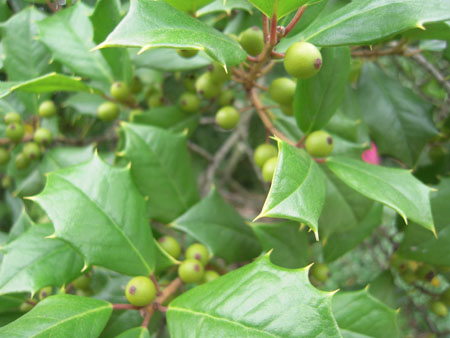
North American mistletoe (Phoradendron flavescens) and European mistletoe (Viscum album): when concentrated into teas or extracts, both cause vomiting and severe abdominal cramps. Isolated reports of illness from eating small quantities of mistletoe berries are most likely isolated idiosyncratic occurrences; systematic analyses demonstrate little evidence of any toxicity other than gastroenteritis.[3]
Ipecac (Cephaelis ipecacuanha): the syrup contains emetine and cephaline alkaloids, which cause violent vomiting and cramping.
Oxalis (Oxalis triangularis): contains oxalic acid which, in large amounts, is toxic and interferes with mineral absorption.[4][Figure caption and citation for the preceding image starts]: OxalisFrom private collection of Gerald O'Malley [Citation ends].

Ginkgo (Ginkgo biloba): ingestion of seeds/leaves/leaf extracts can cause nausea, diarrhoea, and gastrointestinal upset.[Figure caption and citation for the preceding image starts]: GinkgoFrom private collection of Gerald O'Malley [Citation ends].
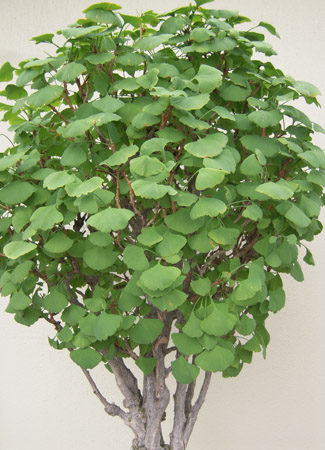
Plants containing ribosome-inactivating protein 2 (castor bean [contains ricin; Ricinus communis], rosary pea [contains abrin; Abrus precatorius], black locust [Robinia pseudoacacia]) are directly cytotoxic with early signs of severe gastroenteritis.
Sesbania species (bagpod, rattlebox) contain saponins and cytotoxic sesbanimide. There was one death reported in 2021.[5]
Hepatotoxic plants
Plant-induced hepatotoxicity can be multifactorial and has been reported after ingestion of several plants.[6]
Ragwort (Senecio jacobaea), other Senecio species, rattleweed (Crotalaria species), Heliotropium, comfrey (Symphytum officinale), Eupatorium species, and Tussilago farfara: examples of the numerous plants containing pyrrolizidine alkaloids (can cause liver necrosis).[7][Figure caption and citation for the preceding image starts]: SenecioFrom private collection of Gerald O'Malley [Citation ends].

Distaff thistle (Atractylis gummifera): contains atractyloside.
Kava kava (Piper methysticum): contains kavalactone, kavain, flavokavain B, all shown to be hepatotoxic.
Creosote bush (Larrea tridentate): contains nordihydroguaiaretic acid.
Blue-green algae: contains peptide microcystin.
Pennyroyal (Mentha pulegium) and Hedeoma pulegioides: contains pulegone.
Germander (Teucrium chamaedrys): contains teucrin A.
Senna contains sennosides, which are metabolised by colonic bacteria to rhein anthrone, a reactive hepatotoxic compound.
Cardiotoxic plants
Many plants contain cardiac glycosides in varying concentrations that have actions on the heart virtually identical to digoxin.[8]
Lily of the valley (Convallaria), foxglove (Digitalis), oleander (Nerium), suicide tree (Cerbera odollam), milkweed (Asclepias), Calotropis species, Ledebouria species, and red squill (Urginea) species: contain cardioactive steroids that cause bradycardia, hypotension, and heart block.[9][Figure caption and citation for the preceding image starts]: OleanderFrom private collection of Gerald O'Malley [Citation ends].

Monkshood contains aconitine, mesaconitine, and hypaconitine, all alkaloids that cause dysrhythmias by activating sodium channels.[10]
Green tea (Camellia sinensis), yerba mate (Ilex paraguariensis), bala (Sida cordifolia), and ma huang (Ephedra) species: contain stimulants such as caffeine, theophylline, and ephedrine, which can cause tachyarrhythmias and hypertension.
Yew leaves and seeds (Taxus species): contain taxine, which causes sodium and calcium channel blockade and may lead to ventricular arrhythmias.[11][Figure caption and citation for the preceding image starts]: YewFrom private collection of Gerald O'Malley [Citation ends].
 [Figure caption and citation for the preceding image starts]: YewFrom private collection of Gerald O'Malley [Citation ends].
[Figure caption and citation for the preceding image starts]: YewFrom private collection of Gerald O'Malley [Citation ends].
Tejocote (Crataegus mexicana) and candlenut (Aleurites moluccanus), sold as a dietary supplement online, are often substituted with Oleander peruviana.
Blue cohosh (Caulophyllum thalictroides), poison hemlock (Conium maculatum), golden chain (Laburnum anagyroides), Indian tobacco (Lobelia inflata), lupin (Lupinus species), and tobacco (Nicotiana tabacum): contain nicotine-like alkaloids and may cause tachyarrhythmias.
Khat (Catha edulis): contains cathinone, which may cause tachyarrhythmias.
Bitter orange (Citrus aurantium): contains synephrine, an alpha-receptor agonist that may cause tachyarrhythmias.
Neurotoxic plants
The mechanism of plant-induced neurotoxicity is largely dependent on what aspect of the neurological system is affected. Several plant species can cause hallucinations when inhaled by smoking (e.g., marijuana, coca), or when consumed as food or drink. However, this is most commonly reported after ingestion of lysergic acid and mescaline alkaloid-containing plants and cacti.[12]
Opium poppy seeds (Papaver somniferum): contain opium and many refined opiates, including morphine, thebaine, codeine, papaverine, and noscapine.
Marijuana (Cannabis sativa): contains tetrahydrocannabinol.
Coca (Erythroxylum coca): contains cocaine alkaloids.
Absinthe (Artemisia absinthium): contains thujone.
Peyote cactus (Lophophora williamsii): contains mescaline (hallucinations may occur after ingestion of very small amounts).
Nutmeg (Myristica fragrans): in very large doses nutmeg can cause delirium, a sense of blood rushing to the head, euphoria, and dissociation.[13]
Hawaiian baby woodrose (Argyreia nervosa): contains lysergic acid.
Morning glory (Rivea corymbosa, Ipomoea violacea, Argyreia): contains lysergic acid amide and ergonovine.
Salvia divinorum contains salvinorin A, a potent hallucinogen.
Kratom (Mitrogyna speciosa): contains mitragynine, an indole alkaloid that stimulates mu and delta opiate receptors.
Some herbal blends are adulterated with unlabelled chemicals with hallucinogenic properties, such as JWH018, HU210, and mephedrone.
Khat (Catha edulis): contains cathinone, which may cause central nervous system (CNS) stimulation.
Calea zacatechichi, for reasons that are not clear, produces CNS depression.
Ayahuasca is a mixture of Banisteriopsis caapi (containing harmine and harmaline – monoamine oxidase [MAO] inhibitors) and Psychotria viridis (containing N,N-dimethyltryptamine).
Gelsemium sempervirens contains indole alkaloids (gelsemine) that block nicotinic receptors and may cause ataxia, profound muscle weakness, and seizures.[14]
Rambutan (Nephelium lappaceum) seeds contain gamma-aminobutyric acid (GABA), an alpha-glucosidase inhibitor, and a glycoprotein that can cause anaphylaxis.[15]
Peripheral neuropathy and neuromuscular weakness can occur with ingestion of the aconitine alkaloids, strychnine alkaloids, curare alkaloids, brucine alkaloids, grayanotoxins, and Schwann-cell-destroying karwinskia toxins.[16][17]
Monkshood, wolfsbane, and devil helmet (Aconitum species): contain aconitine alkaloids.
Poison nut, quaker button, strychnos seed (Strychnos nux-vomica): contain strychnine alkaloids and brucine alkaloids.
Chondrodendron tomentosum and Strychnos toxifera: contain curare alkaloids.
Azalea (Rhododendron species), fetterbush (Leucothoe fontanesiana), and Kalmia species: contain grayanotoxin.
Buckthorn, coyotilla, tullidora (Karwinskia humboldtiana): contain Karwinskia toxin.
Seizures have been reported most prominently with ingestion of cicutoxin and strychnine alkaloids, and with exposure to numerous plant xenobiotics, including nicotine, thujone, hypoglycin A, hypoglycin B, cyanogenic glycosides (e.g., amygdalin, linamarin), and anisatin.[18]
Water hemlock (Cicuta maculata) and other Cicuta species: contain cicutoxin. Water hemlock is the most common plant involved in fatalities.[19] It is usually misidentified as wild parsnip or turnip and eaten by adults.[20][Figure caption and citation for the preceding image starts]: CicutaFrom private collection of Gerald O'Malley [Citation ends].
 [Figure caption and citation for the preceding image starts]: CicutaFrom private collection of Gerald O'Malley [Citation ends].
[Figure caption and citation for the preceding image starts]: CicutaFrom private collection of Gerald O'Malley [Citation ends]. [Figure caption and citation for the preceding image starts]: CicutaFrom private collection of Gerald O'Malley [Citation ends].
[Figure caption and citation for the preceding image starts]: CicutaFrom private collection of Gerald O'Malley [Citation ends].
Wormwood (Artemisia absinthium), absinthe (Artemisia absinthium), tansy (Tanacetum vulgare), sage (Salvia officinalis), and arborvitae tree: contain thujone.[Figure caption and citation for the preceding image starts]: WormwoodFrom private collection of Gerald O'Malley [Citation ends].
 [Figure caption and citation for the preceding image starts]: Blue sageFrom private collection of Gerald O'Malley [Citation ends].
[Figure caption and citation for the preceding image starts]: Blue sageFrom private collection of Gerald O'Malley [Citation ends]. [Figure caption and citation for the preceding image starts]: Blue sageFrom private collection of Gerald O'Malley [Citation ends].
[Figure caption and citation for the preceding image starts]: Blue sageFrom private collection of Gerald O'Malley [Citation ends].
Japanese star anise (Illicium anisatum, Illicum lanceolatum): contains anisatin, while Chinese star anise (Illicum verum) contains veranisatins.[Figure caption and citation for the preceding image starts]: Star aniseFrom private collection of Gerald O'Malley [Citation ends].
 [Figure caption and citation for the preceding image starts]: Star aniseFrom private collection of Gerald O'Malley [Citation ends].
[Figure caption and citation for the preceding image starts]: Star aniseFrom private collection of Gerald O'Malley [Citation ends]. [Figure caption and citation for the preceding image starts]: Star aniseFrom private collection of Gerald O'Malley [Citation ends].
[Figure caption and citation for the preceding image starts]: Star aniseFrom private collection of Gerald O'Malley [Citation ends].
Poison nut, quaker button, and strychnos seed (Strychnos nux-vomica): contain strychnine alkaloids.
Blue cohosh (Caulophyllum thalictroides), poison hemlock (Conium maculatum), golden chain (Laburnum anagyroides), Indian tobacco (Lobelia inflata), lupin (Lupinus species), laburnum, and tobacco (Nicotiana tabacum): all contain nicotine-like alkaloids that can cause overstimulation of the nicotine receptors.
Ginkgo (Ginkgo biloba): uncooked ginkgo seeds contain ginkgotoxin, and consumption of large quantities of seeds over time can cause death; ginkgo leaf and ginkgo leaf extracts appear to contain little ginkgotoxin.[Figure caption and citation for the preceding image starts]: GinkgoFrom private collection of Gerald O'Malley [Citation ends].

Nephrotoxic plants
There are a number of plants that contain compounds that can cause renal damage.
Aristolochia species: contain aristolochic acid, which causes irreversible interstitial nephritis.
Ephedra species: contain ephedrine, which crystallises in concentrated urine, causing kidney stones.
Carambola (Averrhoa carambola): contains soluble oxalates that may cause oxalate nephropathy and encephalopathy.
Ackee fruit (Blighia sapida): contains hypoglycin A and B, which may cause hypoglycaemia and seizures.
Dermatotoxic plants
Plant-induced dermatitis and mucous membrane irritation is typically caused by irritant chemicals such as oxalate crystals.
Philodendron, Caladium, and peace lily (Spathiphyllum) species: contain oxalate crystals that cause immediate pain when chewed or crushed.[21]
Chili or cayenne peppers (Capsicum annuum): contain a phenylpropanoid that releases substance P from local sensory nerve endings, causing intense burning pain in whatever part of the body comes into contact with the plant.[Figure caption and citation for the preceding image starts]: CapsicumFrom private collection of Gerald O'Malley [Citation ends].
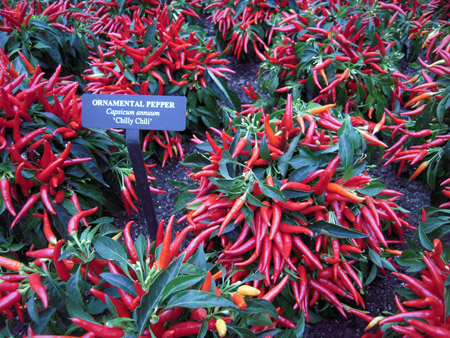 [Figure caption and citation for the preceding image starts]: CapsicumFrom private collection of Gerald O'Malley [Citation ends].
[Figure caption and citation for the preceding image starts]: CapsicumFrom private collection of Gerald O'Malley [Citation ends]. [Figure caption and citation for the preceding image starts]: CapsicumFrom private collection of Gerald O'Malley [Citation ends].
[Figure caption and citation for the preceding image starts]: CapsicumFrom private collection of Gerald O'Malley [Citation ends].
Ginkgo (Ginkgo biloba): ingestion of seeds/leaves/leaf extracts can cause allergic skin reactions due to urushiol-like alkylphenols.[Figure caption and citation for the preceding image starts]: GinkgoFrom private collection of Gerald O'Malley [Citation ends].

Stinging nettles (Urtica dioica) have stinging hairs that release histamine, acetylcholine, and serotonin. Tree nettles (Dendrocnide or Laportea species) have stinging hair that contain calcium oxalate.
St John’s wort (Hypericum perforatum) contains hypericin, a photosensitiser.
Various plants contain furocoumarins or psoralens that are photosensitisers (celery, parsnip, limes, bergamot, figs, dill, mustard, carrot, giant hogweed [Heracleum mantegazzianum]).
Common ivy (Hedera helix) contains a contact sensitiser, falcarinol.
Plants causing photodermatitis such as pawpaw (Asimina triloba), parsnip (Pastinaca sativa), and rue (Ruta graveolens).
Some wild grasses produce a grass inflorescence (flower-bearing part) called foxtail. The plant contains a pointed anterior section and barbed posterior section, which facilitates progressive forward movement after force application. Retrograde movement is prevented by stiff trailing spikelets. Children play with it by making the grass move on the tongue, causing aspiration. Because the grass spike migrates while in the body, it has caused airway obstruction, bronchiectasis, lung abscess, and migration through the pleural cavity.[22]
Haematotoxic plants
Plant-induced coagulopathy is generally caused by ingestion of large quantities of coumarin-containing phenylpropanoids or ginkgolides, which exhibit an antiplatelet aggregation effect.[23]
Sweet vernal grass (Anthoxanthum odoratum), tonka beans (Dipteryx odorata), bedstraw (Galium triflorum), sweet clover (Melilotus), red clover (Trifolium pratense), and horse chestnut (Aesculus hippocastanum) species: contain coumarin or coumarin derivatives, and ingestion of large amounts of the plants may result in severe bleeding.[23]
Ginkgo (Ginkgo biloba): uncooked ginkgo seeds contain ginkgotoxin, which can increase bleeding risks (particularly in people who take anticoagulants); consumption of large quantities of seeds over time can cause death; ginkgo leaf and ginkgo leaf extracts appear to contain little ginkgotoxin.[Figure caption and citation for the preceding image starts]: GinkgoFrom private collection of Gerald O'Malley [Citation ends].

Plant-induced bone marrow suppression has been associated with consumption of antimitotic alkaloids such as colchicines, vincristine, vinblastine, and podophyllum, and other cytotoxins such as ricin-like (type 2) ribosome-inactivating proteins (RIP2), and hypoglycins A and B.[24]
Autumn crocus, meadow saffron (Colchicum autumnale): contain colchicine alkaloids.
Madagascar periwinkle (Catharanthus roseus/Vinca rosea): contains vincristine and vinblastine alkaloids.
North American mayapple (Podophyllum peltatum), Southwestern Chinese Podophyllum aurantiocaule, and Podophyllum delavayi, and other Podophyllum species: contain podophyllum alkaloids.
Castor bean (Ricinus communis): contains ricin, a type 2 RIP.[Figure caption and citation for the preceding image starts]: Castor beanFrom private collection of Gerald O'Malley [Citation ends].

Rosary pea (Abrus precatorius) contains abrin, a type 2 RIP.
Black locust (Robinia pseudoacacia) contains robin, a type 2 RIP.
Multiorgan toxic plants
Antimuscarinic effects are seen with the ingestion of belladonna alkaloid-containing plants.
Jimsonweed/locoweed (Datura stramonium), belladonna (Atropa belladonna), henbane (Hyoscyamus niger), and European or true mandrake (Mandragora officinarum) all contain belladonna alkaloids, ingestion of which can cause severe antimuscarinic symptoms.[16]
Muscarinic effects are seen with the ingestion of solanine alkaloid-containing plants.
Betel nut (Areca catechu), calabar bean/ordeal bean (Physostigma venenosum) and Pilocarpus species all contain muscarinic alkaloids, ingestion of which can cause muscarinic symptoms.[25]
Overstimulation of the nicotine receptors with nicotine-like alkaloids can cause numerous adverse presentations.
Blue cohosh (Caulophyllum thalictroides) contains methylcytisine.
Poison hemlock (Conium maculatum) can cause rhabdomyolysis and renal failure secondary to consumption either of a plant or of birds who have eaten the plant.
Golden chain (Laburnum anagyroides), Indian tobacco (Lobelia inflata), lupin (Lupinus species), laburnum, and tobacco (Nicotiana tabacum) all contain nicotine-like alkaloids that can cause overstimulation of the nicotine receptors.[8]
Acidosis can occur with complete chewing of certain seeds.
Cassava (Manihot esculenta) and Prunus species contain cyanogenic glycosides amygdalin and linamarin, respectively, which are released when seeds are chewed.[26]
Multiorgan failure can occur from inhibition of microtubule formation throughout the body.
Colchicine alkaloids from autumn crocus and glory lily.
Podophyllotoxin from mayapple.
Vincristine/vinblastine from periwinkle.
Taxol from yew.
Use of this content is subject to our disclaimer